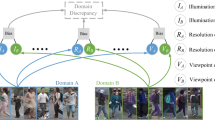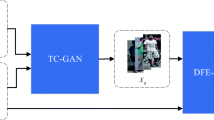Abstract
Person re-identification(re-ID) techniques have been rapidly improving with the development of deep neural networks, and the accuracy of fully supervised re-ID models is already very high. However, when person re-identification models with supervised learning are used directly in unlabeled target scenes, the accuracy is greatly reduced. This is due to the large disparity between the domains of different datasets, such as resolution, lighting changes and occlusion. At the same time, the existing re-ID methods based on domain transfer have the problem of blurred images due to big gap between domains. Therefore, in this paper, a DCGAN (Deep Convolutional Generative Adversarial Network) is added to the unsupervised cross-domain re-ID model, which can allow the target domain distribution to be adequately fitted to the labeled domain distribution, so that the re-ID model trained in source domain can be used on the target domain without large fluctuations due to domain shift. By comparing with the UMDL(Unsupervised Multi-task Dictionary Learning) method, rank-1 and rank-5 are improved by 9.61% and 17.81%, respectively, when the model trained from Market-1501 is used in the GRID dataset, and by 9.52% and 14.14%, respectively, when compared with the GAN(Generative Adversarial Networks)-based method under the same experiment.






Similar content being viewed by others
References
Bousmalis K, Trigeorgis G, Silberman N et al (2016) Domain separation networks. Advances in neural information processing systems, pp 343–351
Chen G, Lu Y, Lu J et al (2020) Deep credible metric learning for unsupervised domain adaptation person re-identification. In: ECCV, Glasgow, UK, pp 643–659
Chen Y, Zhu X, Gong S (2019) Instance-guided context rendering for cross-domain person re-identification. In: Proceeding ICCV, Seoul, Korea, pp 232–242
Dai Y, Liu J, Sun Y et al (2021) IDM:, An Intermediate Domain Module for Domain Adaptive Person Re-ID, arXiv:2108.02413
Fan L, Li T, Fang R et al (2020) Learning Longterm Representations for Person ReIdentification Using Radio Signals. In: Proceeding CVPR, Seattle, SEA, USA, pp 10699–10709
Fang W, Zhang FH, Sheng VS, Ding YW (2018) Method for improving CNN-based image recognition using DCGAN. CMC: Comput Mater Contin 57:167–178
Fu K, Peng J, Zhang H, Wang X, Jiang F (2020) Image super-resolution based on generative adversarial networks: a brief review. Comput Mater Contin 64(3):1977–1997
He L, Liang J, Li H et al (2018) Deep spatial feature reconstruction for partial person reidentification: Alignment-free approach. In: Proceeding CVPR, Salt Lake City, SLC USA, pp 7073–7082
He L, Wang Y, Liu W et al (2019) Foreground-aware pyramid reconstruction for alignment-free occluded person re-identification. In: Proceeding CVPR, State of California, CA, USA, pp 8450–8459
He K, Zhang X, Ren S et al (2016) Deep residual learning for image recognition. In: Proceeding CVPR, Las Vegas, LV USA, pp 770–778
Hermans A, Beyer L, Leibe B (2017) In defense of the triplet loss for person re-identification, arXiv:1703.07737
Huang Y, Wu Q, Xu JS et al (2019) SBSGAN: Suppression Of inter-domain background shift for person re-identification. In: Proceeding CVPR, State of California, CA, USA, pp 9527–9536
Isola P, Zhu JY, Zhou T, et al. (2017) Image-to-image translation with conditional adversarial networks. In: Proceeding CVPR, Hawaii, HI, USA, pp 1125–1134
Loy CC, Xiang T, Gong S (2009) Multi-camera activity correlation analysis. In: Proceeding CVPR, Miami, Florida, USA, pp 1988–1995
Mekhazni D, Bhuiyan A, Ekladious G, et al. (2020) Unsupervised Domain Adaptation in the Dissimilarity Space for Person Re-identification. In: ECCV, Glasgow, UK, pp 159–174
Miao J, Wu Y, Liu P et al (2019) Pose-guided feature alignment for occluded person reidentification. In: Proceeding CVPR, State of California, CA, USA, pp 542–551
Peng P, Xiang T, Wang Y et al (2016) Unsupervised cross-dataset transfer learning for person re-identification. In: Proceeding CVPR, Las Vegas, LV, USA, pp 1306–1315
Shu R, Bui HH, Narui H et al (2018) A dirt-t approach to unsupervised domain adaptation, arXiv:1802.08735
Song C, Huang Y, Ouyang W et al (2018) Mask-guided contrastive attention model for person re-identification. In: Proceeding CVPR, Salt Lake City, SLC, USA, pp 1179–1188
Su K, Li J, Fu H (2011) Smart city and the applications. In: ICECC Ningbo, China, pp 1028–1031
Su C, Li J, Zhang S et al (2017) Pose-driven deep convolutional model for person reidentification. In: Proceeding CVPR, Hawaii, HI, USA, pp 3960–3969
Su C, Zhang S, Xing J et al (2016) Deep attributes driven multi-camera person reidentification, European conference on computer vision, vol 2016. Springer, Cham, pp 475–491
Sun Y, Xu Q, Li Y et al (2019) Perceive where to focus: Learning visibility-aware part-level features for partial person re-identification. In: Proceeding CVPR, State of California, CA, USA, pp 393–402
Sun Y, Zheng L, Deng W, Wang S (2017) Svdnet for pedestrian retrieval. In: Proceeding ICCV, Venice Italy, pp 3800–3808
Tian M, Yi S, Li H, Li S, Zhang X, Shi J, Yan J, Wang X (2018) Eliminating background-bias for robust person reidentification. In: Proc. CVPR, Salt Lake City, SLC, USA, pp 5794–5803
Tzeng E, Hoffman J, Darrell T et al (2015) Simultaneous deep transfer across domains and tasks. In: Proceeding CVPR, Boston, BSN, USA, pp 4068–4076
Wang T, Gong S, Zhu X et al (2014) Person re-identification by video ranking. In: ECCV, pp 688–703
Wang G, Yang S, Liu H, et al. (2020) High-Order Information matters: learning relation and topology for occluded person Re-Identification. In: Proceeding CVPR, Seattle, SEA, USA, pp 6449–6458
Wang J, Zhu X, Gong S et al (2018) Transferable joint attribute-identity deep learning for unsupervised person re-identification. In: Proceeding CVPR, Salt Lake City, SLC, USA, pp 2275–2284
Wei L, Zhang S, Gao W, et al. (2018) Person transfer gan to bridge domain gap for person re-identification. In: Proceeding CVPR, Salt Lake City, SLC, USA, pp 79–88
Wei L, Zhang S, Gao W et al (2018) Person transfer gan to bridge domain gap for person re-identification. In: Proceeding CVPR, Salt Lake City, SLC, USA, pp 79–88
Yang F, Zhong Z, Luo Z et al (2021) Joint noise-tolerant learning and meta camera shift adaptation for unsupervised person Re-Identification. In: Proc CVPR, pp 4855–4864
Zhai Y, Lu S, Ye Q et al (2020) Ad-cluster: Augmented discriminative clustering for domain adaptive person re-identification. In: Proceeding CVPR, Seattle, SEA, USA, pp 9021–9030
Zhao S, Gao C, Zhang J et al (2020) Do Not Disturb Me:, Person Re-identification Under the Interference of Other Persons, arXiv:2008.06963
Zhao F, Liao S, Xie GS et al (2020) Unsupervised domain adaptation with noise resistible mutual-training for person re-identification. In: ECCV, Glasgow, UK, pp 1–18
Zheng M, Karanam S, Wu Z et al (2019) Re-identification with consistent attentive siamese networks. In: Proceeding CVPR, State of California, CA, USA, pp 5735–5744
Zheng L, Shen L, Tian L, et al. (2015) Scalable person re-identification: A benchmark. In: Proceeding CVPR, Boston, BSN, USA, pp 1116–1124
Zheng Z, Yang X, Yu Z et al (2019) Joint discriminative and generative learning for person re-identification. In: Proceeding CVPR, State of California, CA, USA, pp 2138–2147
Zheng Z, Zheng L, Yang Y (2017) Unlabeled samples generated by gan improve the person re-identification baseline in vitro. In: Proceeding CVPR, Hawaii, HI, USA, pp 3754–3762
Zheng Z, Zheng L, Yang Y (2017) Unlabeled samples generated by gan improve the person re-identification baseline in vitro. In: Proceeding ICCV, Venice, Italy, pp 3754–3762
Zhong Z, Zheng L, Luo Z et al (2019) Invariance matters: Exemplar memory for domain adaptive person re-identification. In: Proceeding CVPR, State of California, CA, USA, pp 598–607
Zhong Z, Zheng L, Zheng Z et al (2018) Camera style adaptation for person re-identification. In: Proceeding CVPR, Salt Lake City, SLC, USA, pp 5157–5166
Zhu JY, Park T, Isola P, et al. (2017) Unpaired image-to-image translation using cycleconsistent adversarial networks. In: Proc. CVPR, Hawaii, HI, USA, pp 2223–2232
Acknowledgements
This work was supported by the National Natural Science Foundation of China (Grant No.42075007), the Open Grants of the State Key Laboratory of Severe Weather(No.2021LASW-B19), the Open Project of Provincial Key Laboratory for Computer Information Processing Technology under Grant KJS1935, Soochow University, and the Priority Academic Program Development of Jiangsu Higher Education Institutions, Graduate Scientific Research Innovation Program of Jiangsu Province under Grant no. KYCX21_1015.
Author information
Authors and Affiliations
Corresponding author
Ethics declarations
Conflict of Interests
The Authors declares that there is no conflict of interest.
Additional information
Publisher’s note
Springer Nature remains neutral with regard to jurisdictional claims in published maps and institutional affiliations.
Rights and permissions
Springer Nature or its licensor holds exclusive rights to this article under a publishing agreement with the author(s) or other rightsholder(s); author self-archiving of the accepted manuscript version of this article is solely governed by the terms of such publishing agreement and applicable law.
About this article
Cite this article
Fang, W., Yi, W., Pang, L. et al. Study of cross-domain person re-identification based on DCGAN. Multimed Tools Appl 81, 36551–36565 (2022). https://doi.org/10.1007/s11042-022-13526-3
Received:
Revised:
Accepted:
Published:
Issue Date:
DOI: https://doi.org/10.1007/s11042-022-13526-3




